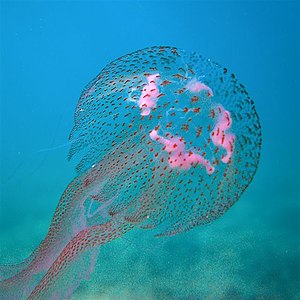Luminous jellyfish
| Luminous jellyfish | ||||||||||||
|---|---|---|---|---|---|---|---|---|---|---|---|---|

Pelagia noctiluca |
||||||||||||
| Systematics | ||||||||||||
|
||||||||||||
| Scientific name | ||||||||||||
| Pelagia noctiluca | ||||||||||||
| Forsskål , 1775 |
The luminescent jellyfish ( Pelagia noctiluca ), also Feuerqualle called, is an umbrella jellyfish from the family of Pelagiidae and one of the few European jellyfish whose nematocysts can penetrate the human skin. The generic name Pelagia is derived from the Greek pelagós 'sea' (there is also a saint of the same name ). It owes its species name noctiluca - "the nocturnal luminescent" - to its weak, nocturnal glow, which becomes visible when the jellyfish is shaken ( bioluminescence ).
description
The shade is arched and has the shape of a hemisphere or bell . It can reach a diameter of 10–12 cm. The color of this medusa ranges from pale pink to mauve and brownish, the surface of the umbrella is covered with pink or mauve- colored, nettle cell- reinforced warts . The screen bears sixteen marginal lobes and eight marginal sense organs on the underside. Around the mouth opening there are four mouth tentacles , curled on the outside , on the edge of the umbrella eight thread-like, up to one meter long catch tentacles . The trap tentacles are covered with countless nematocysts , which in turn are filled with protein oxides with a molar mass of 50–150 kDa.
Occurrence and way of life
The light jellyfish lives cosmopolitan in warmer seas (for example the Mediterranean , the Red Sea and the Gulf of Mexico ) and occurs mostly in schools. The migrant populations can be kilometers long and occur at a depth of up to 20 m. Pelagia noctiluca does not go through a sessile polyp stage , the adult animals release fully developed young medusas in autumn . The usual prey for these jellyfish are free-swimming sea squirts , smaller jellyfish, and zooplankton .
Systematics
Pelagia noctiluca belongs to the class of umbrella jellyfish (Scyphozoa) from the tribe of the cnidarians (Cnidaria), its family (Pelagiidae) includes the species Pelagia flaveola , P. noctiluca and P. panopyra . A synonym for P. noctiluca is Pelagia perla ( Slabber, 1781 ).
Luminous jellyfish and humans
The microscopically small harpoons of stinging cells penetrate the human skin. The nettle poison causes immediate contact urticaria , which is painful but not life-threatening. In a few cases, however, systematisation (nausea, vomiting and headache) can occur. First aid measures include immediately removing adherent tentacles and neutralizing the poison with a magnesium sulfate solution .
Mass occurrences of luminous jellyfish threaten aquaculture . There have been cases where up to 100,000 salmon have been killed. In recent years there have been reports of unusual mass occurrences in the Mediterranean, which then lead to beach closures. Such incidents are problematic for the respective local tourism industry because the bathers stay away.
The luminous jellyfish can be called an invasive species , as the actual deep sea jellyfish is periodically driven into coastal waters, where it causes damage.
literature
- Pierre Tardent: Marine Biology: An Introduction . Georg Thieme Verlag, Stuttgart / New York 2005 (3rd edition), ISBN 3135708039 .
- RN Gibson, Margaret Barnes: Oceanography and Marine Biology, An Annual Review (= Oceanography and Marine Biology , Vol. 38). Taylor & Francis, London 2000, ISBN 0415238420 .
- Gerd Plewig, P. Thomas: Progress in practical dermatology and venereology 2006: Lectures and Dia-Klinik® of the 20th advanced training week 2006. Advanced training week for practical dermatology and venereology eV c / o Clinic and Polyclinic for Dermatology and Allergology Ludwig-Maximilians-University Munich . Springer, Heidelberg 2007, ISBN 3540305149 .
Web links
- Description of Pelagia noctiluca on Marlin.ac.uc. (English)
- Description of Pelagia noctiluca on WoRMS.org (English)
Individual evidence
- ↑ a b Description of Pelagia noctiluca on Marlin.ac.uc. (English); accessed on September 19, 2012.
- ↑ a b c Gerd Plewig, P. Thomas: Advances in practical dermatology and venereology 2006 . Pp. 347-349.
- ↑ a b c Description of Pelagia noctiluca on WoRMS (English); accessed on September 19, 2012.
- ^ RN Gibson, Margaret Barnes: Oceanography and Marine Biology . Pp. 113 & 119-123.
- ↑ Senckenberg: Effects of the mass occurrence of jellyfish ("jellyfish blooms")
- ↑ Pierre Tardent: Marine Biology . Pp. 43, 238 & 254.
- ^ Entry in the Invasive Species Compendium
